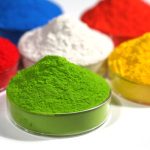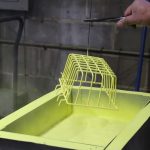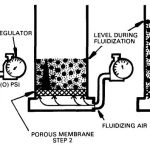Tag: Fluidized bed powder coating
Fluidized bed powder coating system has three main sections. A top powder hopper where the powder is held, a porous plate which allows air to pass through, and a sealed bottom air chamber. When pressurized air is blown into the air chamber it passes through the plate and causes the powder to float or “fluidize”. This allows the metal part to be coated to be moved through the powder with little resistance.
Fluidized bed powder coating is also called dipping powder coating due to its application method. It is usually applied with dipping tank or automatic dipping production line.
Fluid Bed Powder Coating is sponsored by PECOAT® Thermoplastic Coatings
USE METHOD

Is fluidized bed powder coating a good fit for your products?

There are several questions that need to be asked. First, since fluidized bed powder coating generally applies a thicker coating, can the end part withstand the dimensional changes? Unlike electrostatic coating, fluid bed coating will generally smooth over any small details in the parts, such as embossed serial numbers, metal imperfections, etc. This can be extremely beneficial for parts where Faraday Cage effects are problematic. Welded wire products are good examples. Electrostatic spray has a hard time getting into theRead More …
Electrostatic fluidized Beds for Powder Coatings

Electrostatic fluidized beds are especially applicable to continuous coating of sheets,wire screen and small simple configuration parts.The effective coating range is only 3-4inches over the bed and will not coat parts with deep recesses.Coatings range from 20-74um on relatively high speed lines. Electrostatic Fuidized Bed Advantages include: High speed lines ; Easily automated; Acceptable to continuous length products Disadvantages include: Coating area limited to 3-4inches above bed Restricted product flexibility; Best for 2 dimensional parts
Fluid Bed Powder Coating Application Process

Fluid bed powder coating consists of immersing a hot part into a bed of powder, allowing the powder to melt on the part and build a film, and subsequently providing enough time and heat for this film to flow into a continuous coating. The part should be immersed in the fluidized bed as quickly as possible after removing it from the preheat oven to keep heat loss at a minimum. A time cycle should be established to keep this timeRead More …
What are the common fluidized bed powder coating process parameters?
There are no common parameters in the process of fluidized bed powder coating since it changes dramatically with part thickness. Two-inch thick bar stock can be coated with functionalized polyethylene by preheating to 250°F, dip coated and will most likely flow out without any post heating. Conversely, thin expanded metal may have to be preheated to 450°F to achieve the desired coating thickness, and then post heated at 350°F for four minutes to complete the flow out. We have neverRead More …
Brief introduction of fluidized bed powder coating
The fluidized bed powder coating system has three main sections. A top powder hopper where the powder is held, a porous plate which allows air to pass through, and a sealed bottom air chamber. When pressurized air is blown into the air chamber it passes through the plate and causes the powder to float or “fluidize”. This allows the metal part to be coated to be moved through the powder with little resistance. Fluidized bed application is accomplished by preheatingRead More …
